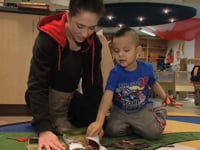3. Opportunities for communicating and learning

Children are naturally curious and interested in the world around them. They are multi-sensory learners who need to watch, try, touch, investigate, listen, question, explore and generally be “hands-on”. Children benefit when adults pay attention to children’s interests; give them time, space and freedom to play; and respect their curiosity. Overall, children learn best in nurturing relationships with people who care about them and respect their curiosity. Attentive interactions that pay attention to children’s interests and allow them to explore are much more important than expensive equipment or the latest must-have toy.
Watch as Jeremy’s parents support his interest in sticks and puddles.
In your experience, is this kind of exploration by young children encouraged?
If not, can you think of ways to help parents understand the importance of letting children investigate and explore?
In the next video, watch this playful interaction between a mother and son as he has a snack in his highchair. Notice how he communicates and how his mother picks up on what he is “telling her”.
How did the child communicate that he wanted his mother to keep singing?
What do you think makes music an important factor for encouraging communication and learning?
In the next set of slides, consider the learning opportunity presented to a toddler by an attentive adult.
Frequency of communication between adults and children is something that can be influenced. Talking with children is an important part of their early experiences, both at home and in early childhood programs. In the next video, watch as the early childhood educator supports a four year old’s language development.
In the next video, Melanie Walters, supervisor of Kittiwake Daycare in Vancouver, discusses how the educators in her program had to be flexible when children wanted to climb a willow tree, rather than use it as a nest or hiding place.
For many children around the world, attending an early childhood program is the first time they have to interact with adults and peers in a large group. The adults who work in these settings have a big responsibility to provide guidance, nurturance and opportunities for learning that support the development of all children.
In the next video, Dr. David Philpott, professor in the Faculty of Education at Memorial University, explains this in the context of children with identified exceptionalities.
What are the trends that Philpott identifies? Which ones resonate with you and your experiences?
Philpott mentions a “backlash against inclusion” that contrasts with other societal values that are welcoming and respectful of individual needs of children. What does he mean by this?
What are his more hopeful and positive messages about inclusion for young children? Think of examples of how you can apply the concept of “universal design of learning”.
In the following video, early childhood educators in First Nations communities in Canada share their ideas about the importance of play in early learning and child care programs.
Do you think the concept that children learn so much through play is widely understood in society?
The video refers to the need to involve parents in decisions regarding what children learn. How do you think programs can encourage that kind of parental input?
Creating learning opportunities for all children in early years programs requires careful consideration, observation and planning. Watch the following slide show to see some examples of children playing and learning. As you watch, think about the role that adults have had in supporting children’s play.
In the next pages, various aspects that can support and foster children’s learning are explored, including:
- guiding and teaching,
- planning environments for learning, and
- creating curriculum frameworks
Strategies and tools to support learning are relevant for parents, educators, health care providers and others involved with young children.







